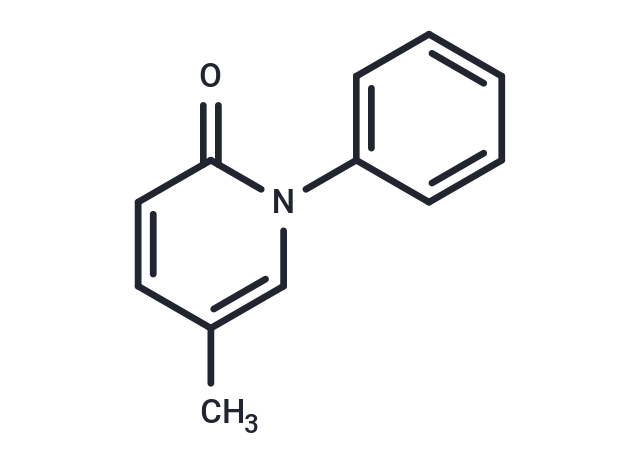Shopping Cart
- Remove All
 Your shopping cart is currently empty
Your shopping cart is currently empty

Pirfenidone (AMR69) inhibits the production of CCL2 and CCL12 in fibroblasts and also decreases TGF-β2 protein levels. Pirfenidone is an antifibrotic agent that is commonly used in studies related to pulmonary fibrosis and also has anti-inflammatory activity.

| Pack Size | Price | Availability | Quantity |
|---|---|---|---|
| 25 mg | $30 | In Stock | |
| 50 mg | $39 | In Stock | |
| 100 mg | $57 | In Stock | |
| 200 mg | $73 | In Stock | |
| 500 mg | $97 | In Stock | |
| 1 g | $147 | In Stock | |
| 5 g | $217 | In Stock | |
| 1 mL x 10 mM (in DMSO) | $39 | In Stock |
| Description | Pirfenidone (AMR69) inhibits the production of CCL2 and CCL12 in fibroblasts and also decreases TGF-β2 protein levels. Pirfenidone is an antifibrotic agent that is commonly used in studies related to pulmonary fibrosis and also has anti-inflammatory activity. |
| In vitro | METHODS: Mouse macrophage-like cell line RAW264.7 was treated with lipopolysaccharide (1 µg/mL) and Pirfenidone (30-300 µg/mL) for 8 h. TNF-α was detected by ELISA assay. RESULTS: Exposure of RAW264.7 cells to Pirfenidone significantly inhibited cell-associated and secreted TNF-α levels. [1] METHODS: Three stromal cell lines from control lungs and three cell lines derived from idiopathic pulmonary fibrosis (IPF) were treated with Pirfenidone (0.1-1 mM) for 6 days and cell viability was measured by MTT assay. RESULTS: Pirfenidone inhibited cell proliferation in a dose-dependent manner. on day 6 of 1 mM Pirfenidone treatment, proliferation was reduced to 47% for control cells and 42% for IPF cells. [2] |
| In vivo | METHODS: To examine the effect of Pirfenidone on pulmonary fibrosis, Pirfenidone (30-100 mg/kg, 0.5% carboxymethylcellulose) was administered orally three times a day for 42 days to ICR mice with bleomycin-induced pulmonary fibrosis. RESULTS: Pirfenidone inhibited pulmonary inflammatory edema and significantly suppressed pulmonary fibrosis. During the development of bleomycin-induced pulmonary fibrosis in mice, Pirfenidone exerted its antifibrotic effects by regulating the levels of lung IFN-γ, bFGF and TGF-β1. [3] |
| Cell Research | Pirfenidone (PFD) is dissolved in DMSO and stored, and then diluted with appropriate media before use[3]. HLECs are seeded in 96-well plates (1×104 cells/well) for 24 hours in α-MEM/10% FBS/1%NEAA, and are cultured in stationary tubes in serum-free medium for 24 hours. And then the culture medium is removed and cells are bathed in α-MEM with 10% FBS and 1% NEAA supplemented with 0, 0.01, 0.1, 0.2, 0.3, 0.5, or 1 mg/mL Pirfenidone for 0, 4, 12, 24, 48, or 72 hours. After incubation with 180 μL α-MEM and 20 μL of 5 mg/mL MTT for 4 hours at 37°C, the MTT solution is discarded. The Formosan precipitates are dissolved in 180 μL DMSO by agitating the dishes for 10 minutes at 200 rpm on an orbital shaker. The absorbance at 490 nm in each well is read with a micro plate reader. We further examined the effects of PFD by refining the concentrations at 0.2, 0.25, 0.3, 0.4, 0.5 and 0.6 mg/mL using the MTT assay[3]. |
| Alias | S-7701,AMR-69, S-7701, AMR69 |
| Molecular Weight | 185.22 |
| Formula | C12H11NO |
| Cas No. | 53179-13-8 |
| Smiles | O=C1N(C=C(C)C=C1)C2=CC=CC=C2 |
| Relative Density. | 1.137 g/cm3 |
| Storage | keep away from direct sunlight,keep away from moisture | Powder: -20°C for 3 years | In solvent: -80°C for 1 year | Shipping with blue ice. | ||||||||||||||||||||||||||||||||||||||||
| Solubility Information | DMSO: 100 mg/mL (539.9 mM), Sonication is recommended. 5% DMSO+95% Saline: 1.85 mg/mL (9.99 mM), In vivo: Please add co-solvents sequentially, clarifying the solution as much as possible before adding the next one. Dissolve by heating and/or sonication if necessary. Working solution is recommended to be prepared and used immediately. H2O: 25 mg/mL (134.97 mM), Sonication is recommended. | ||||||||||||||||||||||||||||||||||||||||
Solution Preparation Table | |||||||||||||||||||||||||||||||||||||||||
5% DMSO+95% Saline/H2O/DMSO
H2O/DMSO
| |||||||||||||||||||||||||||||||||||||||||

Copyright © 2015-2025 TargetMol Chemicals Inc. All Rights Reserved.